 |
|---|
|
|
The four provincial governments of Pakistan administer the four provinces of Pakistan. [1] There is also a federal capital territory and two territories which have similar governments but with some differences. The head of each province is a non-executive Governor appointed by the President. [1]: 68 The Governors play a similar role, at the provincial level, as the President does at the federal level. Each province has a directly elected unicameral legislature (provincial assembly), with members elected for five-year terms. [1]: 70 Each provincial assembly elects a Chief Minister, who then selects a cabinet of ministers from amongst the members of the Provincial Assembly. [1]: 80 Each province also has a High Court, which forms part of the superior judiciary. [2]
Provincial governments
- Government of Balochistan [3]
- Government of Khyber Pakhtunkhwa
- Government of Punjab
- Government of Sindh
Former Provincial Government
Territorial/associated governments
References
- ^ a b c d "Part IV: Provinces" (PDF). National Assembly of Pakistan. 28 February 2012. pp. 57–73. Retrieved 24 December 2013.
- ^ "Part VII: The Judicature" (PDF). National Assembly of Pakistan. 28 February 2012. p. 112. Retrieved 24 December 2013.
- ^ "balochistan.gov.pk". Government of Balochistan. Retrieved 24 December 2013.
- ^ "pabalochistan.gov.pk". Provincial Assembly of Balochistan. Retrieved 24 December 2013.
- ^ "Introduction". High Court of Balochistan. Retrieved 24 December 2013.
- ^ "History". Peshawar High Court. Retrieved 24 December 2013.
- ^ "History". Lahore High Court. Retrieved 24 December 2013.
- ^ "Introduction". Sindh High Court. Retrieved 24 December 2013.
- ^ "History". Islamabad High Court. Retrieved 24 December 2013.
- ^ "President AJ&K Sardar Muhammad Yaqoob Khan". Government of Azad Kashmir. Retrieved 24 December 2013.
- ^ "Prime Minister of Azad Jammu & Kashmir". Government of Azad Kashmir. Retrieved 24 December 2013.
- ^ "Introduction". Legislative Assembly of Azad Jammu and Kashmir. Archived from the original on 16 January 2014. Retrieved 24 December 2013.
 |
|---|
|
|
The four provincial governments of Pakistan administer the four provinces of Pakistan. [1] There is also a federal capital territory and two territories which have similar governments but with some differences. The head of each province is a non-executive Governor appointed by the President. [1]: 68 The Governors play a similar role, at the provincial level, as the President does at the federal level. Each province has a directly elected unicameral legislature (provincial assembly), with members elected for five-year terms. [1]: 70 Each provincial assembly elects a Chief Minister, who then selects a cabinet of ministers from amongst the members of the Provincial Assembly. [1]: 80 Each province also has a High Court, which forms part of the superior judiciary. [2]
Provincial governments
- Government of Balochistan [3]
- Government of Khyber Pakhtunkhwa
- Government of Punjab
- Government of Sindh
Former Provincial Government
Territorial/associated governments
References
- ^ a b c d "Part IV: Provinces" (PDF). National Assembly of Pakistan. 28 February 2012. pp. 57–73. Retrieved 24 December 2013.
- ^ "Part VII: The Judicature" (PDF). National Assembly of Pakistan. 28 February 2012. p. 112. Retrieved 24 December 2013.
- ^ "balochistan.gov.pk". Government of Balochistan. Retrieved 24 December 2013.
- ^ "pabalochistan.gov.pk". Provincial Assembly of Balochistan. Retrieved 24 December 2013.
- ^ "Introduction". High Court of Balochistan. Retrieved 24 December 2013.
- ^ "History". Peshawar High Court. Retrieved 24 December 2013.
- ^ "History". Lahore High Court. Retrieved 24 December 2013.
- ^ "Introduction". Sindh High Court. Retrieved 24 December 2013.
- ^ "History". Islamabad High Court. Retrieved 24 December 2013.
- ^ "President AJ&K Sardar Muhammad Yaqoob Khan". Government of Azad Kashmir. Retrieved 24 December 2013.
- ^ "Prime Minister of Azad Jammu & Kashmir". Government of Azad Kashmir. Retrieved 24 December 2013.
- ^ "Introduction". Legislative Assembly of Azad Jammu and Kashmir. Archived from the original on 16 January 2014. Retrieved 24 December 2013.


